Sustainable enterprise
Sustainable enterprise
De Watergroep does everything in its power to provide the Flemish people with sufficient and high-quality drinking water at home. Now, and in the future. That is why we are working on a climate-resilient drinking water supply. Find out how we ensure that water scarcity does not lead to water shortages.

How can we reduce our carbon footprint?
In 2018 and 2019, several Flemish drinking water companies — including De Watergroep — developed a method to calculate their carbon footprint. With that information to hand, we can get to work on reducing it.
CALCULATING CARBON FOOTPRINT
“Calculating the carbon footprint of a drinking water company is not as easy as it seems, mainly because we consume large volumes of water”, Environment Coordinator Joris Pieters says. “In 2018, De Watergroep and several other drinking water companies took on the challenge of developing a reliable calculation method, based on the methodology of the Dutch KWR Water Research Institute. We completed this quest in 2019. Using the new model, we are now able to calculate the carbon footprint of our drinking water supply — which enables us to reduce it, of course!”
SETTING UP PROJECTS
“2019 was a pivotal year, as we set up a large number of projects that are due to have an impact on our carbon footprint”, according to Joris Pieters. “One example is Leakie, a project that seeks to reduce water losses caused by leaks. We have also installed additional solar panels and taken the first steps in moving towards a greener fleet. The impact of these initiatives will become clear over the coming years. By 2025, we want to see a substantial reduction in our carbon footprint.”
‘Sustainable enterprise’ VOKA charter renewed
In June 2019, De Watergroep obtained VOKA’s ‘Sustainable enterprise’ charter for the second time. Companies who manage to do so three years in a row are awarded the internationally recognised UNITAR certification and are eligible to become ambassadors of the UN’s sustainable development goals.
De Watergroep is a sustainable business at its core. The product we offer — tap water — is one of the most sustainable food products on the market. We supply this product right into our customers’ homes at any time of day and night, without transport or packaging. By committing ourselves to technological innovation, we are giving ourselves the tools to deal with periods of drought. We are also committed to reusing waste water, both in industry and in other sectors.
ACTION POINTS
Our efforts in relation to sustainability may have been rather piecemeal in the past, but we are now evolving towards an integrated approach. To make sure we obtained VOKA’s ‘Sustainable enterprise’ charter for the second time in 2019, we made extra efforts in terms of sustainable enterprise. Our concrete action points included:

- New and existing projects in relation to renewable energy. In addition to purchasing 100 percent renewable energy, De Watergroep is also seeking to exploit every opportunity to produce renewable energy itself, including through the installation of solar panels.
- Reducing our carbon footprint. Replacing diesel service vehicles with electric and hybrid models was one of the ways in which we did so.
- Better water availability. The dry summers of 2017, 2018 and 2019 made it clear that the availability of water in Flanders is subject to great pressure. Within the ‘Sweet H2O’ Blue Cluster project, we examined the ways in which we can make innovative desalination technologies more profitable.